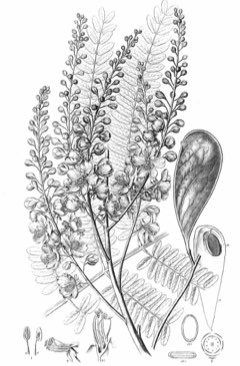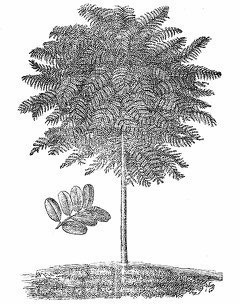 |
|
http://www.edibleplants.org |
 |
| http://www.edibleplants.org |
Translate this page:
Summary
Schizolobium parahyba, commonly known as Brazilian Firetree to Brazilian Fern Tree, is a deciduous tree characterized by a wide-spreading and flat-topped crown and straight, cylindrical bole that can be up to 80cm in diameter. The bark is smooth and gray-green in color. The leaves are bipinnate. The flowers are bright yellow and fruits are pods containing a single oval, smooth, and brown seed. It grows up to 35m in height, commonly in Atlantic rainforests in South America. When fully established, it is tolerant to drought and can succeed in soils of low fertility. It is vigorous growing and a natural pioneer species within its native range. Further, it has symbiotic relationship with certain soil bacteria that form nodules on the roots and fix atmospheric nitrogen. There are no medicinal and edible uses. However, the leaves contain water-soluble substances that act as antidote to snakebites, particularly to that of Bothrops snakes. The seeds are traditionally used to make buttons and beads. The wood is very light and soft and used for doors and panels, toys, soles of shoes, boxes, native huts, canoes, and cheap furniture. It is also used for fuel.
Physical Characteristics

 Schizolobium parahyba is a deciduous Tree growing to 25 m (82ft) by 25 m (82ft) at a fast rate.
Schizolobium parahyba is a deciduous Tree growing to 25 m (82ft) by 25 m (82ft) at a fast rate.
See above for USDA hardiness. It is hardy to UK zone 10 and is frost tender. The flowers are pollinated by Bees.
It can fix Nitrogen.
Suitable for: medium (loamy) and heavy (clay) soils, prefers well-drained soil and can grow in nutritionally poor soil. Suitable pH: mildly acid, neutral and basic (mildly alkaline) soils and can grow in saline soils.
It cannot grow in the shade. It prefers moist soil and can tolerate drought.
UK Hardiness Map
US Hardiness Map
Synonyms
Caesalpinia parahyba (Vell.) Allemao Cassia parahyba Vell. Schizolobium amazonicum Ducke Schizolobiu
Plant Habitats
Edible Uses
References More on Edible Uses
Medicinal Uses
Plants For A Future can not take any responsibility for any adverse effects from the use of plants. Always seek advice from a professional before using a plant medicinally.
None known
References More on Medicinal Uses
The Bookshop: Edible Plant Books
Our Latest books on Perennial Plants For Food Forests and Permaculture Gardens in paperback or digital formats.

Edible Tropical Plants
Food Forest Plants for Hotter Conditions: 250+ Plants For Tropical Food Forests & Permaculture Gardens.
More

Edible Temperate Plants
Plants for Your Food Forest: 500 Plants for Temperate Food Forests & Permaculture Gardens.
More

More Books
PFAF have eight books available in paperback and digital formats. Browse the shop for more information.
Shop Now
Other Uses
Beads Biomass Buttons Containers Fuel Furniture Pioneer Soil conditioner Soil stabilization Wood
Large flowering tree. Public open spaces. Humid shade garden. Agroforestry Uses: A natural pioneer within its native range, the tree is very fast-growing and also fixes atmospheric nitrogen. It is an excellent choice for restoring land to forest and for establishing woodland gardens[419 , K ]. A promising agroforestry species, intercropping is possible because of its light shade[303 ]. It can be used as a shade tree in coffee plantations[341 ]. The tree protects surrounding soil from soil erosion[303 ]. The enormous amount of biomass shed by the tree improves soil fertility[303 ]. Other Uses The flat, brown, hard, oval seeds are used to make buttons and beads[520 ]. The heartwood is light brown; it is not very distinct from the yellowish-white sapwood. The texture is coarse to medium; the grain straight to interlocked; lustre medium to bright; taste is astringent, there is no distinct aroma in seasoned wood. The wood is very light in weight, soft and of low durability in some reports [363 , 418 ]. Though another report says that it is reported to be not susceptible to insect attack and to be durable in salt water[341 ]. It is rarely utilized, possibly because of its repulsive smell when fresh[303 ]. It is used for the insides of doors and panels, toys, soles of shoes, boxes etc[363 , 419 ]. It is also used for native huts, canoes, and cheap furniture[341 ]. The wood can be used for fuel[303 , 418 ].
Special Uses
Food Forest Nitrogen Fixer
References More on Other Uses
Cultivation details
A plant of the tropics, where it is found at elevations from sea level up to 2,200 metres. It grows best in areas where annual daytime temperatures are within the range 20 - 26°c, but can tolerate 9 - 30°c[418 ]. It prefers a mean annual rainfall in the range 1,200 - 1,600mm, but tolerates 1,000 - 1,800mm[418 ]. Grows best in a sunny position[419 ]. Prefers a well drained, moist, loamy to clay soil[303 , 418 ]. Prefers a fertile soil, but can succeed in soils of low fertility[418 ]. Prefers a Ph in the range 5.5 - 6.5, tolerating 4.5 - 7.5[418 ]. Established trees are drought tolerant[418 ]. A very fast growing tree, it can be 8 - 10 metres tall after 2 years[419 ]. It can be grown with a 6 - 8 year pulpwood rotation[418 ]. Annual wood production can be up to 20 tonnes per hectare[418 ]. The tree has enormous double-compound leaves that sometimes exceed 2 metres. These leaves can sometimes make people confuse a young plant with a fern or palm[372 ]. The tree has brittle branches that break off easily in the wind[419 ]. This species has a symbiotic relationship with certain soil bacteria, these bacteria form nodules on the roots and fix atmospheric nitrogen. Some of this nitrogen is utilized by the growing plant but some can also be used by other plants growing nearby[200 ].
References Carbon Farming Information and Carbon Sequestration Information
Temperature Converter
Type a value in the Celsius field to convert the value to Fahrenheit:
Fahrenheit:
The PFAF Bookshop
Plants For A Future have a number of books available in paperback and digital form. Book titles include Edible Plants, Edible Perennials, Edible Trees,Edible Shrubs, Woodland Gardening, and Temperate Food Forest Plants. Our new book is Food Forest Plants For Hotter Conditions (Tropical and Sub-Tropical).
Shop Now
Plant Propagation
Seed - it has a hard seedcoat and may benefit from scarification before sowing to speed up germination. This can usually be done by pouring a small amount of nearly boiling water on the seeds (being careful not to cook them!) and then soaking them for 12 - 24 hours in warm water. By this time they should have imbibed moisture and swollen - if they have not, then carefully make a nick in the seedcoat (being careful not to damage the embryo) and soak for a further 12 hours before sowing. Sow the seed in a partially shaded position in individual containers. A germination rate of around 85% can be expected, with the seed sprouting within 5 - 15 days[419 ].
Other Names
If available other names are mentioned here
Native Range
NORTHERN AMERICA: Mexico (Chiapas, Oaxaca, Quintana Roo, Tabasco, Veracruz de Ignacio de la Llave) SOUTHERN AMERICA: Belize, Costa Rica, Guatemala, Nicaragua, Panama, El Salvador, Venezuela, Brazil, Bolivia, Colombia, Ecuador, Peru
Weed Potential
Right plant wrong place. We are currently updating this section.
Please note that a plant may be invasive in one area but may not in your area so it's worth checking.
Conservation Status
IUCN Red List of Threatened Plants Status : This taxon has not yet been assessed

Growth: S = slow M = medium F = fast. Soil: L = light (sandy) M = medium H = heavy (clay). pH: A = acid N = neutral B = basic (alkaline). Shade: F = full shade S = semi-shade N = no shade. Moisture: D = dry M = Moist We = wet Wa = water.
Now available:
Food Forest Plants for Mediterranean Conditions
350+ Perennial Plants For Mediterranean and Drier Food Forests and Permaculture Gardens.
[Paperback and eBook]
This is the third in Plants For A Future's series of plant guides for food forests tailored to
specific climate zones. Following volumes on temperate and tropical ecosystems, this book focuses
on species suited to Mediterranean conditions—regions with hot, dry summers and cool, wet winters,
often facing the added challenge of climate change.
Read More
Expert comment
Author
(Vell.) S.F.Blake
Botanical References
Links / References
For a list of references used on this page please go here
A special thanks to Ken Fern for some of the information used on this page.
Readers comment
| Add a comment |
|
If you have important information about this plant that may help other users please add a comment or link below. Only comments or links that are felt to be directly relevant to a plant will be included. If you think a comment/link or information contained on this page is inaccurate or misleading we would welcome your feedback at [email protected]. If you have questions about a plant please use the Forum on this website as we do not have the resources to answer questions ourselves.
* Please note: the comments by website users are not necessarily those held by PFAF and may give misleading or inaccurate information.
To leave a comment please Register or login here All comments need to be approved so will not appear immediately.
|
Subject : Schizolobium parahyba
|
|
|
|